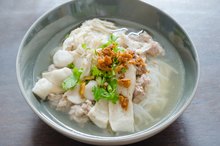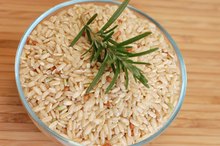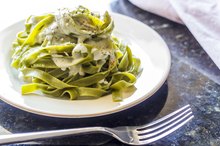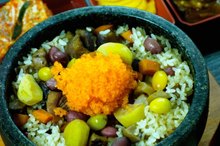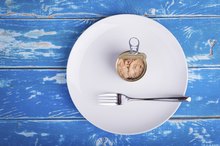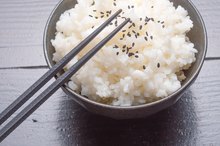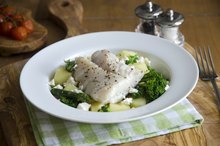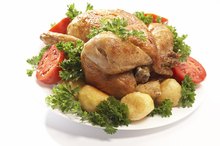The book, “Foods That Harm Foods That Heal,” says rice and tuna are two staple foods that can be included in a healthy diet. A well-balanced diet provides protein, carbohydrates and dietary fat. Rice is your main source of carbohydrates, while tuna provides protein and healthy fats. Rice and tuna also provide you with essential vitamins and minerals.
Nutrition in Tuna
Tuna is an excellent source of potassium, selenium, vitamin B-12 and protein. In addition, it has traces of niacin and phosphorous. A typical serving of tuna contains approximately 180 calories, 30 g of protein and less than 6 g of fat. The primary fat found in tuna is omega-3 fatty acids. According to The Reader’s Digest Association, tuna has been shown to be very beneficial in protecting against heart disease, Alzheimer’s disease and certain cancers 1.
- Tuna is an excellent source of potassium, selenium, vitamin B-12 and protein.
- According to The Reader’s Digest Association, tuna has been shown to be very beneficial in protecting against heart disease, Alzheimer’s disease and certain cancers 1.
Function of Omega-3 Fatty Acids
How Many Calories in Vietnamese Food?
Learn More
Omega-3 fatty acids are considered good fats and are recommended to include in your diet. Omega-3 fatty acids are a type of polyunsaturated fat that helps prevent health problems such as allergies, depression, joint pain, fatigue and poor concentration. The University of California at Berkeley believes the essential fatty acids in tuna play a role in the prevention of cardiovascular disease by reducing inflammation and keeping your blood from clotting 2. In addition, omega-3 fatty acids are necessary for brain and nerve development.
- Omega-3 fatty acids are considered good fats and are recommended to include in your diet.
- The University of California at Berkeley believes the essential fatty acids in tuna play a role in the prevention of cardiovascular disease by reducing inflammation and keeping your blood from clotting 2.
Dangers of Tuna
There are some safety concerns regarding tuna consumption. Tuna has a danger of being contaminated by chemicals such as mercury, pesticides and toxins produced by the fish. In “The Encyclopedia of Healing Foods,” tuna is also considered to be contaminated by bacteria, viruses and parasites 3. For this reason, it is recommended that you should not consume more than two servings of fish a week.
- There are some safety concerns regarding tuna consumption.
- In “The Encyclopedia of Healing Foods,” tuna is also considered to be contaminated by bacteria, viruses and parasites 3.
Benefits of Rice
Brown Basmati Rice Nutrition Information
Learn More
Rice is a versatile grain. The most popular varieties include:
- Arborio
- basmati
- sweet rice
- jasmine
- Bhutanese red rice
- forbidden rice
According to “The Encyclopedia of Healing Foods,” nutritional dietitian Michael Murray claims rice treats digestive, menopausal and cholesterol problems 3. Rice is a source of carbohydrates. Carbohydrates are needed in your diet because it is your primary source of energy and is needed to fuel bodily functions such as digestion.
- Rice is a versatile grain.
- Carbohydrates are needed in your diet because it is your primary source of energy and is needed to fuel bodily functions such as digestion.
Considerations for Rice
White rice is the most processed rice, which means the bran, germ and nutrients have been removed. According to Michael Murray, brown rice is more nutritious as far as vitamins, minerals and calories are concerned. Brown rice is an excellent source of vitamins B-1, B-2, B-3 and B-6. Minerals in rice include manganese, iron, selenium, magnesium and phosphorous. It also contains a greater protein and fiber content.
- White rice is the most processed rice, which means the bran, germ and nutrients have been removed.
Related Articles
References
- "Foods That Harm Foods That Heal"; The Reader's Digest Association; 1997"
- "The Wellness Encyclopediea of Food and Nutrition"; The University of California at Berkeley; 1992
- "The Encyclopedia of Healing Foods"; Michael Murray, ND; 2005
- Fish, tuna, light, canned in water, without salt, drained solids. FoodData Central. U.S. Department of Agriculture. Published April 1, 2019.
- Dhurmeea Z, Pethybridge H, Appadoo C, Bodin N. Lipid and fatty acid dynamics in mature female albacore tuna (Thunnus alalunga) in the western Indian Ocean. PLOS ONE. 2018. doi:10.1371/journal.pone.0194558
- Vitamin B12 or folate deficiency anaemia. National Health Service. Updated 2019.
- Sparkes C, Gibson R, Sinclair A, Else PL, Meyer BJ. Effect of low dose docosahexaenoic acid-rich fish oil on plasma lipids and lipoproteins in pre-menopausal women: A dose⁻response randomized placebo-controlled trial. Nutrients. 2018;10(10). 10.3390/nu10101460
- Simonetto M, Infante M, Sacco RL, Rundek T, Della-Morte D. A novel anti-inflammatory role of omega-3 PUFAs in prevention and treatment of atherosclerosis and vascular cognitive impairment and dementia. Nutrients. 2019;11(10). doi:10.3390/nu11102279
- Damanti S, Azzolino D, Roncaglione C, Arosio B, Rossi P, Cesari M. Efficacy of nutritional interventions as stand-alone or synergistic treatments with exercise for the management of sarcopenia. Nutrients. 2019;11(9). doi:10.3390/nu11091991
- Diabetes superfoods. American Diabetes Association. Updated 2020.
- Histamine toxicity. American Academy of Allergy, Asthma & Immunology. Updated 2020.
- ACOG practice advisory: Update on seafood consumption during pregnancy. American College of Obstetricians and Gynecologists. Updated 2017.
- Canned tuna. Seafood Health Facts: Making Smart Choices Balancing the Benefits and Risks of Seafood Consumption. Updated 2020.
- Selecting and serving fresh and frozen seafood safely. U.S. Food and Drug Administration. Updated 2019.
Writer Bio
Yasser Bailey resides in Austin and began writing articles in 2003. Her articles have been published in the University of Texas campus newspaper and "Self" magazine. She received her Bachelor of Arts in business and government from the University of Texas at Austin. Bailey also just completed her Master of Arts in educational leadership from the University of Texas at Arlington.
